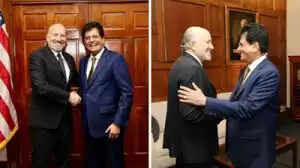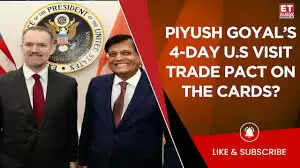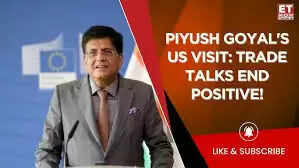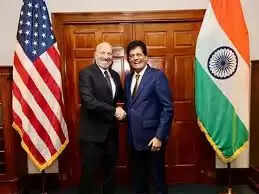Piyush Goyal Visits United States for Trade Talks, Aiming to Resolve Bilateral Trade Disputes
Commerce Minister Piyush Goyal visited the United States for high-level trade talks, seeking to resolve bilateral trade disputes and strengthen economic ties.

Introduction: Strengthening India-U.S. Trade Relations
Commerce and Industry Minister Piyush Goyal’s visit to the United States marks another step in strengthening bilateral trade ties. His mission focused on resolving long-standing trade disputes while exploring new avenues of cooperation in technology, digital trade, and sustainable growth.
Purpose of Piyush Goyal’s Visit
Key Trade Disputes on the Table
India and the U.S. have faced multiple disputes over tariffs, market access, and digital trade policies. Goyal’s visit aimed to bridge differences and set the foundation for smoother trade flows.
Significance of Bilateral Trade Engagements
The U.S. is one of India’s largest trading partners, and dialogue at the ministerial level strengthens both economic and strategic cooperation.

Background: India-U.S. Trade Relations
Growth in Bilateral Trade
India-U.S. trade has grown significantly, crossing $190 billion in 2022, making the U.S. a critical export market for India.
Historical Challenges in Trade Ties
Despite strong ties, disputes over tariffs, agricultural imports, and intellectual property rights have created friction.
Role of Strategic Cooperation Beyond Trade
Beyond commerce, the trade relationship plays into larger strategic frameworks like the Quad alliance and Indo-Pacific partnerships.
Major Issues in the Current Trade Talks
Tariff Disputes and Market Access
India seeks restoration of its Generalized System of Preferences (GSP) benefits, while the U.S. pushes for greater access for its agricultural and dairy products.
Digital Economy and Data Localization
The U.S. has expressed concerns over India’s data localization policies, while India emphasizes digital sovereignty.
Agricultural Exports and Import Restrictions
Differences persist on tariffs applied to U.S. agricultural exports and restrictions on Indian exports like steel and aluminum.
India’s Objectives in the Trade Talks
Expanding Market Access for Indian Goods
India aims to boost pharmaceuticals, textiles, and IT services exports to the U.S.
Resolving WTO-Linked Disputes
India and the U.S. have taken disputes to the World Trade Organization (WTO), and negotiations seek to reduce friction.
Strengthening “Make in India” Through U.S. Partnerships
By deepening U.S. investments, India hopes to enhance domestic manufacturing and job creation.

U.S. Expectations from India
Intellectual Property Protection
The U.S. emphasizes stronger enforcement of intellectual property rights, especially in pharmaceuticals and technology.
Fair Trade Practices and Regulatory Standards
Washington seeks more predictable policies in e-commerce, taxation, and regulatory frameworks.
Opportunities in Defence and Technology
The U.S. is keen to expand cooperation in defence, AI, renewable energy, and semiconductors.
Significance of Resolving Trade Disputes
Boosting Investor Confidence
Successful talks will increase confidence among foreign investors and global corporations operating in India.
Enhancing Strategic Partnership
Resolving trade friction strengthens the broader India-U.S. strategic partnership, vital in global geopolitics.
Building Economic Resilience
Stronger ties with the U.S. help India diversify markets, reducing reliance on traditional trade partners.
Role of Business and Industry Leaders
Engagement with Indian Diaspora in the U.S.
Goyal met members of the Indian diaspora, who play a key role in bridging trade ties through business networks and investments.
Industry Roundtables and Trade Associations
The visit included discussions with U.S. industry chambers, fostering cooperation in investment and supply chain diversification.
Private Sector Contributions to Trade Dialogue
Private companies from both nations emphasized collaboration in IT, e-commerce, and renewable energy.

Global Implications of India-U.S. Trade Cooperation
Impact on Global Supply Chains
Strengthened ties can position India as a key alternative hub in global supply chains, especially amid shifting dynamics from China.
Countering Protectionist Policies
India-U.S. collaboration can set an example for fair, transparent, and mutually beneficial trade practices.
Role in Indo-Pacific Economic Framework
Trade discussions feed into the Indo-Pacific Economic Framework (IPEF), where India and the U.S. are major stakeholders.
Future Prospects of India-U.S. Trade Relations
Moving Toward a Comprehensive Trade Agreement
Though still under discussion, talks may pave the way for a future comprehensive trade deal.
Expanding Cooperation in Digital and Green Economy
Both nations are exploring cooperation in digital services, renewable energy, and green technologies.
Long-Term Vision for Strategic Economic Partnership
A deeper partnership could establish India and the U.S. as pillars of global economic resilience.

FAQs on Piyush Goyal’s U.S. Visit and Trade Talks
Q1: Why did Piyush Goyal visit the U.S.?
A1: To hold trade talks aimed at resolving disputes and boosting bilateral trade cooperation.
Q2: What are the key disputes between India and the U.S.?
A2: Disputes include tariffs, agricultural imports, data localization, and WTO-linked disagreements.
Q3: How important is the U.S. for India’s exports?
A3: The U.S. is one of India’s largest trading partners, especially for IT services, textiles, and pharmaceuticals.
Q4: What does India want from these talks?
A4: Expanded market access, restoration of GSP benefits, and more U.S. investments.
Q5: What are the U.S.’s expectations from India?
A5: Stronger intellectual property protection, fair trade practices, and predictable regulations.
Q6: How do these talks affect global trade?
A6: Successful negotiations could make India a stronger player in global supply chains and enhance Indo-Pacific trade cooperation.
Conclusion: A Step Forward in India-U.S. Economic Diplomacy
Piyush Goyal’s U.S. visit reflects India’s determination to strengthen economic and strategic ties with one of its most important partners. While trade disputes remain, the commitment to dialogue signals progress toward a mutually beneficial framework. With expanding cooperation in technology, manufacturing, and green energy, the India-U.S. partnership is poised to shape global economic trends in the years ahead.
